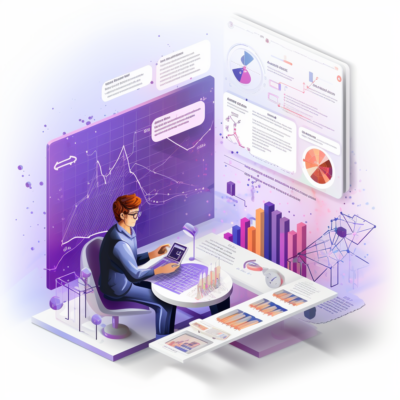
In the analytics realm, “self-service” is a chameleon term, aligned variably with business intelligence, advanced analytics, and concepts like “data democratization” and “citizen data scientist.” It signals a strategic shift toward empowering a wider employee base with robust data access to enable swift, autonomous data-driven decisions—reducing reliance on central BI functions or IT. This paradigm shift isn't just theoretical; it's a battlefield where vendors and consultants fiercely compete, investing heavily to be the self-service purveyor of choice. The business incentives are clear: enhance employee effectiveness and optimize organizational resources—a compelling prospect for any enterprise.
IIA has observed a prevalent disconnect between the lofty expectations and the actual execution of self-service initiatives. We’ve written about this extensively in the past, from Tom Davenport’s “Are Analytics Truly Self-Service?” to Bill Frank’s “Why Self-Service Analytics Isn’t a Thing.” Often mistaken as mere technology solutions, these efforts are misconceived if they result in only replacing query and reporting tools. Contrary to common practice, self-service isn't just about employing technology or transforming employees into analytics experts. Instead, it's a fundamental component of advancing enterprise analytics maturity. It involves redirecting resources from basic reporting to addressing complex business challenges with predictive and prescriptive analytics, fostering a more nuanced and strategic approach to data across the organization.
IIA RAN clients have access to the full self-service framework and supplemental resources here.
Self-service in analytics can significantly bolster a company's analytics maturity in two key scenarios:
- Reporting teams overwhelmed with requests for reports can shift toward creating advanced analytics and AI applications, liberating them from the constant demand for report generation.
- Advanced analytics and AI teams sidetracked by excessive BI reporting demands can refocus on their core mission of developing predictive and prescriptive analytics solutions.
In scenarios with finite analytic manpower, a focused self-service strategy can reshape reporting demands, leading to three key outcomes:
- A reduced demand for reports allows for a sharper focus on instances where retrospective analysis is truly beneficial.
- By decentralizing report generation to analysts closer to the actual business needs, insights are delivered faster.
- Freed-up resources enhance the advanced analytics team's ability to innovate and apply deeper, predictive, and prescriptive analyses to a wider range of business challenges.
In our experience with clients, IIA knows that successful self-service is not about the adoption of any specific technology; an overly tool-centric approach is a recipe for failure amidst a market brimming with overlapping solutions. Instead, the essence of self-service lies in cultivating a cultural shift within the organization. This means incentivizing and, if necessary, mandating a change in how data demands are made and met. It's about aligning organizational behavior with strategic objectives to truly benefit from self-service analytics. Remember, without addressing these fundamental aspects, any self-service initiative is likely to falter.
To enable a demand-side mindset, this blog series offers a framework focused on what we believe are the four elements you will need to work on to find success with self-service on your analytics maturity journey:
- Identifying and classifying the underlying assumptions that elevated self-service to be worked on right now.
- Segmenting the user audience to understand who this effort is truly intended to benefit.
- Establishing the requisite incentivization structure to support the adoption of the self-service effort.
- Converting the reporting/dashboarding demand to predictive/prescriptive demand.
In part 1, we will explore how to the lay groundwork for self-service analytics within the unique history, culture, and characteristics of your organization. Part 2 will discuss demand segmentation, behavioral incentives, and identifying demand for advanced analytics and AI.

Analytics Maturity: Supply and Demand Harmony in the Information Economy Webinar
For over a decade IIA has set the standard for assessing and progressing the maturity of enterprise analytics. Flash back to the founding of IIA and this meant creating awareness around the power of data and analytics to gain a competitive advantage. Now, the challenge lies in adoption. In 2023 technical deficiencies are hardly the problem. Rather, analytics leaders and their teams are breaking through cultural barriers and managing behavioral change in a new era of accountability.
In this interactive session, Jack Philips and Christopher Donovan discuss:
- The value of regularly assessing the analytics maturity of the enterprise and benchmarking against your peers
- The three principles of the information economy and the north star of supply and demand harmony
- Key actions D&A leaders and their teams can take to progress in their analytics maturity journey
Surfacing Assumptions
Initiating a self-service analytics project demands a clearly stated purpose, expected benefits, and anticipated behavioral changes, all universally acknowledged within the organization. Thoroughly examining and articulating these assumptions—whether held by analytics teams or other departments such as sales, marketing, or IT—lays the groundwork for what will change and its value to the organization. Effectively managing this transformation is crucial for success, guiding stakeholders from initial expectations to the tangible deliverables of self-service. For instance, while the head of sales may anticipate quicker data access for timely sales opportunities, the CFO might forecast cost savings by cutting down on external consultants. It's essential to recognize and reconcile these diverse expectations to design a self-service strategy that meets the varied objectives.
Therefore, as you begin to surface assumptions from all the parties involved, there are three questions you will need to understand the answers to in order to move forward successfully:
- What are the driving forces for self-service to you and/or your organization?
- Why is it the right thing for your organization to go from having a BI reporting team to self-service?
- Why is it right for your organization’s analytics maturity aspirations?
For an effective self-service strategy, distinguish between valid demands for descriptive analytics and redundant reporting that constitutes waste. Reports that add no value shouldn't transition to local analytics teams, and those that could evolve into predictive or prescriptive analytics ought to remain with central analytics to maximize their potential.
What are the driving forces for self-service to you and your organization?
When charting a self-service BI course, canvass a wide spectrum of stakeholders—beneficiaries, sponsors, strategists, and HR—to uncover and validate the initiative's broad objectives. Recognize that some needs may mistakenly be tagged for self-service when they actually require advanced analytics or AI; these should be noted for later review. While stakeholders may not bring advanced analytics scenarios ready-made for tools like Tableau, their current descriptive needs and eagerness for new insights can seed future advanced analytics and AI projects. It's crucial to listen deeply to discern the underlying business issues and the potential for transformative analytics solutions down the line.
You are looking to understand:
Why now? Where does the pressure come from? What problems is this expected to solve?
What do you expect this to do for you and your organization?
Are the driving forces like company strategy documented?
Do you have any business cases where this effort makes economic sense?
What assumptions have been made by whom about the role that self-service technology plays in the efforts?
Why is it the right thing for your organization to go from having BI reporting team to self- service?
Educating stakeholders about the current state of business information access, its limitations, and their actual needs is crucial in a self-service initiative. Determine whether they seek merely a more attractive, user-friendly version of existing reports or genuine access to analytics without intermediaries. It’s essential to discern if their dissatisfaction stems from the current system's sluggishness and backlog issues, or if they are content with routine data on past events. Remember, the goal for you, the analytics leader, is to redirect your team's efforts from basic reporting toward higher-value analytics. However, without your constituents' understanding and willingness to take on some reporting tasks, and an appreciation for the insights gained from this resource shift, the transition to self-service could encounter significant obstacles.
Here's what you want to learn:
- Are business users genuinely eager to use data and visualization tools to craft their own insights for daily decision-making?
- Do they have a clear vision of the project's outcome to ensure its success?
- Are they aware that self-service does not equate to becoming data scientists and have realistic expectations of its capabilities? If not, re-education is necessary.
What role is this expected to play in improving the analytics maturity of your organization?
As the analytics leader, it's your duty to spearhead the transition to a robust enterprise analytics function and prepare to enhance advanced analytics and AI initiatives post self-service implementation. Consider:
- Strategy for evolving your analytics function through self-service.
- Changes needed in your role to: Focus on identifying essential self-service BI use cases from the current demand and making them accessible, with strict criteria for using your team's resources.
- Managing stakeholder expectations by: Enlisting planning committee members from both demand and supply sides to communicate updates and drive supportive behaviors for the self-service transition, preventing small issues from escalating.
In the early stages of implementing self-service analytics, it’s vital to understand the change management landscape that awaits. Interactions with various organizational groups will highlight diverse interpretations of self-service: data professionals see it as access liberation, while others view it as autonomy in analysis or the tweaking of dashboards. Expect differing levels of enthusiasm for self-service across departments; sales and marketing might be eager adopters, whereas HR could prefer the status quo. Similarly, while mid-level managers might be ready to embrace change, senior leaders may hesitate, seeing it as another burdensome project. Your strategy must address these varying perceptions and appetites for self-service to ensure a smooth transition.
You may find that despite the scale and resource investment of your self-service initiative, it isn't grounded in overarching strategy documents like an analytics or digital strategy. Ensuring it's integrated into broader corporate strategies can be instrumental in advancing the initiative.

A Framework For Establishing A Self-Service Program eBook
The road to self-service requires flexibility, agility, and resilience as you both incent and compel the demand side to embrace these efforts. To find success with self-service initiatives, IIA recommends leveraging a four-element framework explored in this eBook:
Surface Assumptions: Identify and classify the underlying assumptions about the self-service effort and ground it in an explicit, publicly declared and validated rationale.
Segment Audience: Segment the user audience to understand who this effort is designed to benefit and whether or not your constituents are ready and willing for this self-service effort.
Incentives for Initiatives: Establish an incentivization structure that favors a defined cutover period and developing explicit incentive schemes for each segment
Identify Demand for Analytics: Once you have enabled your demand side to self-service, you must turn your focus to enabling an advanced analytics program by looking for saleable wins.
How to approach technology in a self-service effort
Technology should support, not define, your self-service initiative. You need to bolster both data accessibility for business leaders and the advanced toolset for data professionals, necessitating a technical infrastructure upgrade if the current one falls short. For these technical decisions, consult a select group of knowledgeable individuals, rather than a broad stakeholder ensemble. The choice of analytics and visualization tools must be tailored to your organization's unique needs—perhaps even enhancing what you already have. To ensure the selected tools meet organizational needs, involve potential users in the selection or upgrading process. This careful balance of the right tools and the right people will form the backbone of a successful self-service system.
For effective self-service analytics tool adoption:
- Target users with moderate to high analytics maturity, allowing less skilled users room to grow, while those at the top of the maturity curve use more specialized tools.
- Choose influential users from departments that handle the bulk of high-value analytics and reporting, selecting tools that align with your company's core competencies, like sales and marketing.
- Pick users who are both capable and inclined to mentor others, with support from their managers, to foster company-wide or personal skill development.
In the self-service analytics ecosystem, consider the supporting "back-end" technologies—data platforms, storage, ETL—as foundational to the "front-end" tools. With a legacy back-end that’s often more complex than the front-end, specialized guidance is essential. The advisory group for back-end changes should be compact, including key decision-makers and those controlling the purse strings. This team's mission is to judiciously update only the back-end elements that directly facilitate the self-service initiative, avoiding the pitfall of using this project as an impetus for a complete tech overhaul. In short, focus on what's necessary for self-service, and resist overextending into a full-scale tech revamp.